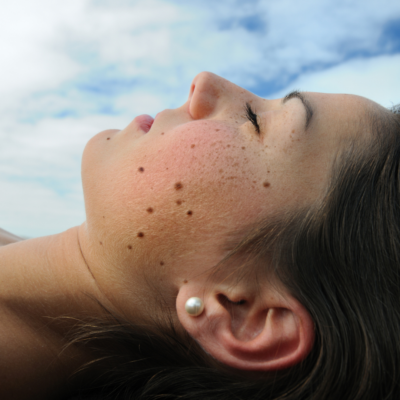Don’t Get Burned This Summer With These Sun Protection Tips
Did you know that UV rays from the sun can damage your skin in as little as 15 minutes? However, that doesn’t mean you have to spend your summer indoors. Here are some great sun protection tips to help you safely enjoy the weather while preventing sunburn!
Plan ahead
- Get into the habit of applying sunscreen daily, even if the weather is cloudy or overcast.
- If possible, try to plan outdoor activities outside of the peak sun hours, which are from 10am – 4pm.
Know Your SPFs
- For dry skin – opt for a sunscreen lotion that is at least SPF 30 and applies evenly. We recommend this SPF 50+ Moisturizing Sunscreen. Consider using a daily moisturizer that contains SPF to help hydrate and protect your skin.
- For oily skin – select a sunscreen that is labeled non-comedogenic to avoid clogging pores. Look for an oil-free sunscreen to prevent a greasy finish, like our Sheer SPF 50+.
- For normal skin – look for SPF 30 or higher, broad spectrum sunscreen to protect against both UVA and UVB rays. Our Physical Tinted BB Cream Sunscreen offers the highest level of broad spectrum protection and has mattifying oil control with a slight tint.
- For sensitive skin – find a non-chemical sunscreen with zinc oxide that is fragrance-free and hypoallergenic. Sunscreens that have a “National Eczema Association Seal of Acceptance” label are a great choice for people who have eczema or sensitive skin. Our Elite SPF 30 Sunscreen is chemical, oil and fragrance-free, as well as non-comedogenic. An excellent option for sensitive skin.
- For an active lifestyle – spray-on sunscreens may seem like a great choice for the athletic type who is always on the go and needs serious sun protection. However, there is concern that sprays may be diluted, wear off easily, are not applied properly and do not provide as effective coverage as a lotion or cream. Instead, choose a sunscreen lotion or cream that includes an 80-minute, sweat-resistant label if you’re going to be active and outdoors for long periods of time, and don’t forget to reapply every 80 minutes. We suggest the California Skin Institute Sport Sunblock SPF 45.
- For children – spray sunscreens might seem like a good idea for busy-body children, but they may not actually offer the full coverage your child needs. For optimal sun protection, select a zinc based, water-resistant cream or lotion and reapply every 40-80 minutes. California Skin Institute’s Elite SPF 30 Sunscreen is formulated with purest pharmaceutical grade 17% Micronized Zinc Oxide to provide the highest level of broad spectrum UVA/UVB protection.
If you are on medications or are currently using topical creams, be sure to ask your doctor if the products make your skin more sensitive to the sun or increase your chances of sunburn.
Be wary. A higher SPF does not necessarily equate to better sun protection. Properly applied SPF 50 blocks up to 98% of UV rays and any SPF above that is marginally more effective. This means SPF 100 does not block double the amount of UV rays that SPF 50 blocks.
Additionally, SPF effectiveness depends on application. Most people do not apply the full one ounce needed to cover your entire body, approximately the same amount it takes to fill a shot glass. Read the label and reapply SPF frequently, as directed, especially if you are going to be out in the sun for long periods of time.
Don’t rely on sunscreen alone. Cover up with sun protective clothing such as:
- A long-sleeved shirt or rash guard
- A wide-brimmed hat or baseball cap
- A swimsuit cover-up
- Sunglasses that block 99-100% of UV rays – when shopping for sunglasses, look for a “UV absorption up to 400 nm” or “Meets ANSI UV Requirements” label.
Relax in the shade. Find a shaded spot away from the sun’s direct rays or bring something portable along. Shaded solutions include:
- A beach umbrella
- Lightweight canopy or tent
- Trees that offer shade if you are in a park or outdoor area
- A park pagoda or a covered public shelter
Sometimes despite our best efforts, sunburn can still happen. Perhaps you got caught up in a game of beach volleyball or simply missed a spot behind your ears when applying sunscreen.
So you got burned? Here’s what to do:
- Apply a soothing aloe vera or soy moisturizer to prevent skin from blistering and a hydrocortisone cream to ease itchiness and discomfort
- Use cool water to shower at low pressure if possible or take a cool bath
- Apply a cold compress
- Drink plenty of water to replenish since a burn draws water to the skin’s surface and away from the rest of the body
- Anti-inflammatory drugs including ibuprofen or aspirin can help alleviate discomfort
- Avoid tight-fitting strappy clothing that can irritate the skin
- Do wear tightly-woven fabrics that provide coverage against the sun’s rays
- Stay out of the sun!
If you have severe blistering, fever, chills or feel disoriented, seek medical help. Never pop blisters, as this could lead to a more serious infection. Take the right steps to protect your skin by purchasing a broad-spectrum sunscreen.



 / 291 Reviews
/ 291 Reviews